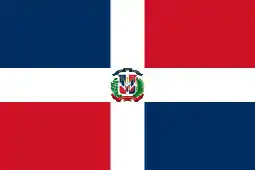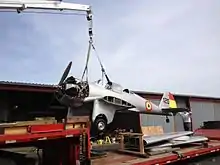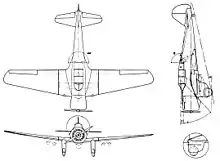Curtiss-Wright CW-19
The Curtiss-Wright CW-19 was a civil utility aircraft designed in the United States in the mid-1930s and built in small quantities in a number of variants including the CW-23 military trainer prototype.
| CR-2, CW-19, and CW-23 | |
|---|---|
.jpg.webp) | |
| Curtiss-Wright CW-19 Coupe | |
| Role | Civil utility aircraft |
| Manufacturer | Curtiss-Robertson Airplane Manufacturing Company, Curtiss-Wright |
| Designer | Don Berlin, Carl Scott, George Page |
| First flight | 1935 |
| Primary users | Chinese Air Force Cuban Air Force |
| Number built | Approximately 30 |
Design and development
Originally conceived as the Curtiss-Robertson CR-2 Coupe shortly before the Curtiss-Wright merger and the dropping of the Curtiss-Robertson brand, it was an all-metal, low-wing cantilever monoplane of conventional configuration with fixed tailwheel undercarriage and side-by-side seating for two. A prominent feature on all versions other than the original CR-2 prototypes was the large "trouser"-style wheel spats. While the design was never perfected for the civil market it was originally intended for, a militarized version was soon developed that replaced the side-by-side cabin with tandem seating and added provision for guns and bombs.
Operational history
Curtiss-Wright hoped that in this form it could be sold on the export market as a ground-attack machine. But orders were disappointing, with only 20 purchased by the Chinese Air Force and three by the Cuban Air Force. An unarmed trainer version was also developed and offered to the USAAC but no orders were placed.
In a final attempt to find a market for the design, engine power was increased from 450 hp (340 kW) to 600 hp (450 kW), and a retractable undercarriage was fitted. In this form, designated CW-23, the aircraft was offered once again to the USAAC, this time as an advanced trainer, but once again the service was not interested. The CW-19 did, however, form the basis of the far more successful CW-21 and CW-22 designs.
Variants
- CR-2 - Curtiss-Robertson prototype with strut-braced wing and unfaired undercarriage (two built)
- Model 19L - prototype with cantilever wing, spatted undercarriage and Lambert R-266 engine (one built)
- Model 19W - prototype with Warner Super Scarab engine (one built)
- Model 19Q - Lycoming R-680-B2 Seaplane design (none built)
- Model 19R Fighter - militarized version with tandem seating, weapons mountings, and Wright J-6-7 engine (23 built)
- Model 19R Long Range Trainer - Extra center mounted 35 gallon aux tank pod. One fixed forward gun, one rear manned gun.
- Model 19R Light Bomber - Two .30 cal guns with two A-3 bomb racks. (563 lb)
- Model 19R Photo Reconnaissance - Two bottom mounted camera ports.
- Model 19R Attack (special) - single seat with wing mounted guns (none built)
- Model 19R Advanced Trainer - Pratt&Whittney R-760-E2 or R-975-E3 engine choices.
- Model 19R Seaplane - proposed 1936 variant of the 19Q (none built)
- Model A19R - military trainer offered to USAAC (three built, one later converted to CW-22)[1]
- Model B19R - projected civil version of Model A19R (none built)
- Model C19R - Amphibian standard trainer R-975-E3 (none built)
- Model C19R - Amphibian advanced trainer (none built)
- Model C19R - Amphibian fighter - One forward gun, one manned gun (none built)
- Model C19R - Amphibian photographic aircraft - Fairchild KB-3 camera mount
- Model C19Z - Standard Amphibian or Seaplane trainer - Pratt & Whitney Wasp SC-G
- CW-23 - advanced military trainer with Pratt & Whitney R-1340 engine and retractable undercarriage (one built)
Operators
 Bolivia received 10 CW-19Rs in 1938, with four remaining in service in 1949.[2]
Bolivia received 10 CW-19Rs in 1938, with four remaining in service in 1949.[2] China purchased 20 CW-19Rs.[3]
China purchased 20 CW-19Rs.[3] Cuba received five CW-19Rs in 1937, one remaining in service until 1948.[2]
Cuba received five CW-19Rs in 1937, one remaining in service until 1948.[2] Dominican Republic purchased two CW-19Rs in 1937.[2]
Dominican Republic purchased two CW-19Rs in 1937.[2] Ecuador received six in 1936, remaining in service until 1943.[2]
Ecuador received six in 1936, remaining in service until 1943.[2]
Survivors

- The plane pictured was originally shipped from La Paz, Bolivia to Patrick AFB on April 12, 1995 by owners Debra Boostrom - Hoedebecke of Dixie Air Supply and Maggie Glendinning-Welch. It arrived via a lift from a Bolivian Air Force C-130 Hercules. It was then trucked to San Antonio, Texas for restoration and preparation for flight to Oshkosh, Wisconsin for the annual fly-in. In accordance with the verbal agreement between Debra Boostrom - Hoedebecke and Bolivian government, it was agreed to maintain the current Bolivian markings on the aircraft for historical purposes. Following complete renovation of the engine and aircraft, the CW-19R was flown to the Oshkosh Fly-In in July 1996, where it was bestowed with the Rarest Warbird award.[4]
- A single example arrived at Fantasy of Flight on March 22, 2013. Pictured is the plane packed for shipment and ready to start its journey. The plane currently sports Bolivian markings. The plane will enter the Fantasy of Flight maintenance queue and be restored to airworthy status.[5] On February 10, 2014, it flew its first test flight since restoration began.[6]
Specifications (CW-19R)

Data from Curtiss Aircraft 1907–1947[7]
General characteristics
- Crew: 2
- Length: 26 ft 4 in (8.03 m)
- Wingspan: 35 ft 0 in (10.67 m)
- Height: 7 ft 2 in (2.18 m)
- Wing area: 174 sq ft (16.2 m2)
- Airfoil: Curtiss CW-19 Special[8]
- Empty weight: 1,400 lb (635 kg)
- Gross weight: 3,500 lb (1,588 kg)
- Powerplant: 1 × Wright R-760E2 Whirlwind 7-cylinder air-cooled radial piston engine, 350 hp (260 kW)
- Propellers: 2-bladed fixed-pitch metal propeller
Performance
- Maximum speed: 185 mph (298 km/h, 161 kn)
- Cruise speed: 164 mph (264 km/h, 143 kn)
- Rate of climb: 1,890 ft/min (9.6 m/s)-
Armament
- Guns: 1 to 3 × fixed, forward-firing 0.300 in (7.62 mm) machine-gun + 1 × trainable, rearward-firing 0.300 in (7.62 mm) machine-gun
- Bombs: provision for underwing bomb load-
References
| Wikimedia Commons has media related to Curtiss-Wright CW-19. |
Notes
- Hagedorn, Dan. "The Curtiss-Wright 19R All Metal Light-Combat Aircraft." Skyways, October 1995.
- Hagedorn 1992, p.76.
- Bowers 1979, p. 411.
- Sport Aviation Magazine March, 1996
- "Fantasy of Flight's Facebook Page". Fantasy of Flight. Retrieved 2013-03-22.
- "Fantasy of Flight's Facebook Page". Fantasy of Flight. 2014-02-11. Retrieved 2014-02-11.
- Bowers, Peter M. (1979). Curtiss aircraft, 1907-1947. London: Putnam. pp. 410–413. ISBN 0370100298.
- Lednicer, David. "The Incomplete Guide to Airfoil Usage". m-selig.ae.illinois.edu. Retrieved 16 April 2019.
Bibliography
- Bowers, Peter M. Curtiss Aircraft 1907–1947. London: Putnam, 1979. ISBN 0-370-10029-8.
- Hagedorn, Dan. "Curtiss Types in Latin America". Air Enthusiast, Issue Forty-Five, March–May 1992, pp. 61–77. ISSN 0143-5450.
- Hagedorn, Dan (February 1998). "Curtiss-Wright 19R, appareil de combat léger "tout métal" (1e partie)" [Curtiss-Wright 194, All-metal Light Fighter]. Avions: Toute l'aéronautique et son histoire (in French) (59): 15–19. ISSN 1243-8650.
- Hagedorn, Dan (March 1998). "Curtiss-Wright 19R, appareil de combat léger "tout métal" (2e partie)" [Curtiss-Wright 194, All-metal Light Fighter]. Avions: Toute l'aéronautique et son histoire (in French) (60): 32–36. ISSN 1243-8650.
- Hagedorn, Dan (April 1998). "Curtiss-Wright 19R, appareil de combat léger "tout métal" (dernière partie)". Avions: Toute l'aéronautique et son histoire (in French) (61): 2–7. ISSN 1243-8650.
- Soulane, Stéphane (July 1998). "Courrier des Lecteurs" [Readers' Letters]. Avions: Toute l'aéronautique et son histoire (in French) (64): 5. ISSN 1243-8650.
- Taylor, Michael J. H. Jane's Encyclopedia of Aviation. London: Studio Editions, 1989, p. 288.
- World Aircraft Information Files. London: Bright Star Publishing, File 891 Sheet 55.